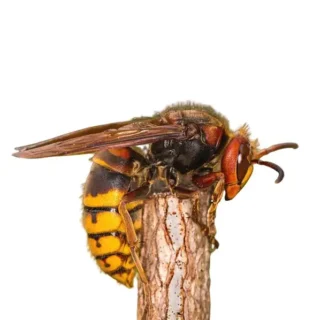Bald-Faced Hornets in McAlpin
The bald-faced and the yellowjacket have many similarities, but the bald-faced hornet gets its name from the ivory-white markings on its face. When compared to other flying insects, they are relatively large and will attack if they perceive their nest to be under threat. They tend to nest in landscaping features and structures including attics and structural voids. The wasps live in colonies that can contain thousands of individuals.
Bald-Faced Hornet Habitat
It is common for the bald-faced hornet to construct its large, paper nest near areas where people work, play, and live. They will place nests in trees, around light structures, under eaves, and inside outdoor playhouses. The typical size of a finished nest is about the size of a football or basketball. The nests are egg-shaped and gray-colored with the potential to grow quite large; some reaching the size of 24 inches in length and 30 inches in diameter! During the spring and early summer, worker hornets will build their nests by chewing on natural wood fibers.
Bald-Faced Hornet Behavior, Threats, or Dangers
The venomous sting from a bald-faced hornet can cause swelling and pain for around 24 hours. Allergic reactions to the hornet’s sting are often similar to regular bee sting allergies. They will forage for food in trash receptacles and for food and drinks that are consumed outdoors. They will also eat ripe fruit found on farms, vineyards, and gardens. In autumn, they are more likely to invade homes due to the cooler temperatures and reduction of food.
As with many stinging insects, these pests will sting if they feel threatened or their nest is in danger. If a nest is located near human activity, it is important to contact a professional hornet control company for stinging insect control or nest removal.
Need help with Bald-Faced Hornet control?
Leave your information below and we’ll be in touch with a FREE quote!
"*" indicates required fields
*During normal business hours. After hours calls will be returned the next business day.





